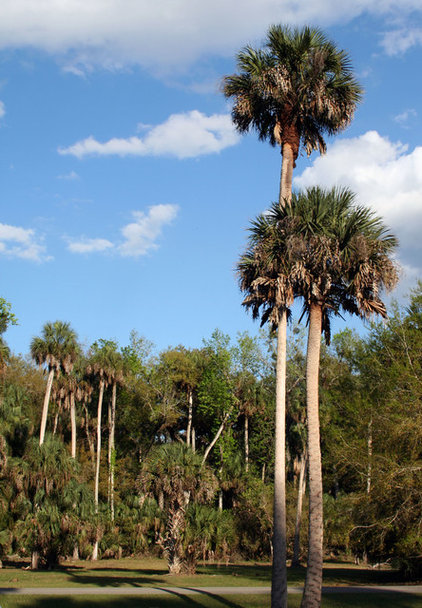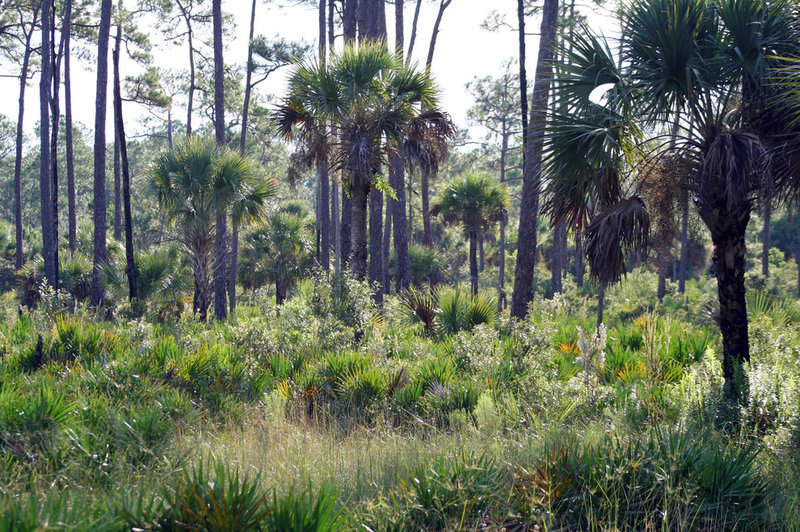This palm is a survivor, too. It can live to be well over a hundred years old and is capable of surviving frost, freezes, extreme drought, fire, salt spray, floods and hurricanes. If you remember seeing one of these palms on TV behind a weatherman through horizontal rain, my point has been made. Early spring is also the best time to transplant one into your garden, since the roots remain more or less dormant from fall until then. Here’s everything you need to know to get started.
 Botanical name: Sabal palmetto
Botanical name: Sabal palmettoCommon names: Sabal palm, cabbage palm
Origin: Native to the U.S. Gulf Coast states, from North Carolina to Florida and Texas, and to Cuba, Puerto Rico and the Bahamas
Where it will grow: Hardy to 10 degrees Fahrenheit (USDA zones 8 to 11, find your zone); otherwise marginal. Some have had success in colder zones.
Water requirement: Extremely drought tolerant once established; also very flood tolerant
Light requirement: Partial shade to full sun
Mature size: Can eventually reach 60 to 90 feet tall and 12 feet wide at the crown; slow growing
Benefits and tolerances: Attracts wildlife; lends a graceful look and can stay in scale with most landscapes; tolerant of drought, floods, salt and frost
Seasonal interest: Flowers in summer, attracting honeybees and other pollinators before forming black fruit
When to plant: Fall to early spring for transplants; anytime for container-grown plants
 Lendry Homes
Distinguishing traits. Sabal palms are so common throughout their native areas that their olive green and tan leaves just seem to blend into the background like longleaf pines or fire hydrants, until you take a second glance and notice them emerging from the understory of a swamp or sprouting from a foothold in a parking lot. When a ray of light happens to illuminate the arching leaves as if they were panes of a stained glass window, the effect can be magical.
Lendry Homes
Distinguishing traits. Sabal palms are so common throughout their native areas that their olive green and tan leaves just seem to blend into the background like longleaf pines or fire hydrants, until you take a second glance and notice them emerging from the understory of a swamp or sprouting from a foothold in a parking lot. When a ray of light happens to illuminate the arching leaves as if they were panes of a stained glass window, the effect can be magical.The ability of these palms to blend into their surroundings can be useful for a gardener hoping to achieve a relaxed and naturalistic look, but don’t think for a moment that they can’t handle center stage. There is no Gainesville landscape that can’t be improved by the cheery rounded crown of a sabal palm casting a shadow on its lap siding, and you just can’t picture the historic districts of Savannah, Georgia, or St. Augustine, Florida, without envisioning sabal palms and live oaks among their old brick buildings. A sabal palm’s solitary silhouette against the open water of a river, a salt marsh or an ocean is the very picture of paradise. These palms play well with others, but they can really make quite the impression as a solo act.
 Sabal palm has a strong presence to be sure, but it’s also strong in countless other ways. It’s resilient enough to thrive in most gardens within its zone range, growing on sand dunes, in swamps and in lavishly planted gardens. You can even find full-size trees sprouting from cracks in the pavement in the middle of the city. These palms tolerate drought, fire, wind, floods, frost, freezes and lightning. It’s even been theorized that the sabal palms found occasionally with multiple heads are a result of their being struck by lightning and continuing to grow despite the damage. Left to their own devices, they can grow to live well over a hundred years, enriching your Gainesville home's landscape.
Sabal palm has a strong presence to be sure, but it’s also strong in countless other ways. It’s resilient enough to thrive in most gardens within its zone range, growing on sand dunes, in swamps and in lavishly planted gardens. You can even find full-size trees sprouting from cracks in the pavement in the middle of the city. These palms tolerate drought, fire, wind, floods, frost, freezes and lightning. It’s even been theorized that the sabal palms found occasionally with multiple heads are a result of their being struck by lightning and continuing to grow despite the damage. Left to their own devices, they can grow to live well over a hundred years, enriching your Gainesville home's landscape.
 Tongue & Groove
How to use it. Sabal palm’s downside is that, unlike the more readily available desert fan palm (Washingtonia robusta, zones 9 to 11), it’s glacially slow at forming a trunk and often has to be purchased with a trunk already formed if you want to end up with a proper “tree” in the garden. But that’s not necessarily a bad thing, since faster-growing palms can grow so quickly that you might regret planting them after only several years.
Tongue & Groove
How to use it. Sabal palm’s downside is that, unlike the more readily available desert fan palm (Washingtonia robusta, zones 9 to 11), it’s glacially slow at forming a trunk and often has to be purchased with a trunk already formed if you want to end up with a proper “tree” in the garden. But that’s not necessarily a bad thing, since faster-growing palms can grow so quickly that you might regret planting them after only several years.Compared to more formal-looking species, like Canary Island date palms (Phoenix canariensis, zones 8b to 11) and windmill palms (Trachycarpus fortunei, zones 7b to 11), sabal palms are loose and informal palms that are at their best when planted in a naturalistic way — singly, scattered or in clumps. You could plant two flanking a grand entrance only to find after several years that they’ve stopped matching and one has grown taller than the other. That said, they can still look very good in formal gardens as long as you use enough and symmetry isn’t that important. In the garden here, for example, the five palms could grow to different heights and lean at odd angles without compromising the subtle and subdued composition in the least.
For a lush and layered look, you can plant ferns, bromeliads and succulents directly inside the “boot” (where the leaves meet the trunk). With regular watering during the first few weeks to get them established, you’ll be rewarded with a vertical display of hanging gardens.
 A. Tate Hilliard, Architect/Builder
Planting notes. An established sabal palm needs hardly any care, but it will respond well to moist soil and occasional feedings. Contrary to popular belief, palms do not require pruning — a full and rounded head of leaves looks more attractive and is a haven for wildlife, such as mosquito-devouring bats and tree frogs. Aesthetic concerns aside, the biggest mistake seems to be planting palm trees under telephone lines, where they will eventually die or have to be removed.
A. Tate Hilliard, Architect/Builder
Planting notes. An established sabal palm needs hardly any care, but it will respond well to moist soil and occasional feedings. Contrary to popular belief, palms do not require pruning — a full and rounded head of leaves looks more attractive and is a haven for wildlife, such as mosquito-devouring bats and tree frogs. Aesthetic concerns aside, the biggest mistake seems to be planting palm trees under telephone lines, where they will eventually die or have to be removed. Seedling sabals are more difficult to transplant, so it’s worthwhile to pay extra for getting trunked specimens delivered from a specialty nursery. They will arrive without leaves and can be planted directly in the ground upon delivery. If you would like more information on having The Master's Lawn Care landscaping your Gainesville home. Give us a call.
To get them established quickly, transplant from fall to early spring and keep the soil moist until a few leaves appear. Plant palm trees 5 to 10 feet away from walls, houses and other structures, and consult the nursery about using stakes to prop the trees up until the roots become established.
 Debra Yates Great Space, Inc.
Purchasing and planting sabal palms might take a little more effort than most other garden plants, but they will become some of the most low-maintenance plants in your garden for years to come.
Debra Yates Great Space, Inc.
Purchasing and planting sabal palms might take a little more effort than most other garden plants, but they will become some of the most low-maintenance plants in your garden for years to come.
